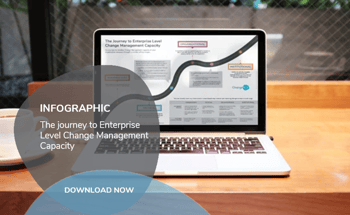
In the first post of this blog series we looked at a definition of Enterprise Change Management (ECM), how the unprecedented level of disruption is increasingly driving the need for it in organisations and how the impact of digital transformation is providing a significant opportunity to build your Enterprise Change Management capability. Both quickly and cost-effectively.
In this second post, we move on to look at the importance of assessing Change Management maturity and consider 2 key questions:
- What level of change management maturity would you need to deliver your change ambitions?
- What’s your starting point and the best plan to deliver your ECM goals?
Organisations are under pressure to change, more than ever before
To successfully introduce an Enterprise Change Management strategy, an organisation needs a level of change management maturity, which requires a significant investment of time and effort.
When working with clients we use our Change Management Maturity model with the four levels shown below to:

- assess the organisation’s current maturity level and our starting point
- determine the gap to being able to develop the level of ECM needed to support change demands
- build a development roadmap and the most realistic timeframe for building enterprise agility into the organisation.
Each of the Change Management Maturity levels, beyond the purely technical at level 0, has its own standards that must be achieved to master that stage of maturity.
We take a closer look at these in turn below:
Level 1 - Rudimentary level
At this level, there is a strong focus on the technical aspects of projects. Project implementation contains little or no change management beyond basic change management communications and training. Any resistance to change is likely to be viewed as ‘anti-organisation’. Employee engagement is focused on communication and is seen as putting forward a rational case for change that people will understand and comply with.
The key leadership mindsets observed at this level are:
‘People are rational and will do the right thing. If they don’t, they will have to comply anyway.’ ‘All this change stuff is a bit soft and unnecessary.’
This level of maturity tends to be enough for change that is slow and incremental in scope. Any increase in the demand for change is unlikely to be supported by this capability level and workplace productivity will drop considerably. We would say that there are no maturity standards worth noting at this level.
Level 2 - Tactical level
At this level, we observe change management being applied, but that application is inconsistent across different projects. Its usage is typically a reaction to problems experienced during project delivery, such as employee resistance, rather than built into the original project plan. Senior sponsors are usually active in supporting change management as an idea but are more inclined to rely on external change management consultants for more strategic advice and to be able to move fast. Change management at this level tends to be driven by a ‘coalition of the willing’ – a small group of enthusiastic early process adopters working on projects and concerned about what happens to people.
Key leadership mindsets at this level are:
‘Let’s try to get as much buy-in as we can with the budget and time that is available. Ultimately project timelines are crucial.”
This level of maturity may be sufficient for a number of focused initiatives, say on improving ways of operating. There are some standards at this level: different change models are used; a small number of specialists lead big change efforts and there may be generic change management education that people can access.
Level 3 - Organisational level
This level is characterised by change management being aligned with other organisational processes, making it easier to apply across different change project in different parts of the organisation. As such, the application of change management is more consistent. The use of change management is also made easier at this level because the organisation agrees on the need for a single change management methodology on major projects, and project delivery communities such as IT, Process and HR, who all feel a strong sense of ownership for the integration of change management into their business processes. At this level, there is also an increase in the number of change management roles, and project-focused workshops that help people learn and apply change management skills and processes to their projects just-in-time. With this level of internal capability building, the dependency on external consultants is reduced. Instead there is likely to be a core group of skilled change agents in place, plus appropriate training for local managers, and even employees, to allow them to play their active part in change.
Key leadership mindsets at this level are:
‘We will be successful if we have project plans with a strong people component.’ ‘Securing people’s commitment and helping them to shift their behaviour in support of the change are essential to success.’
This is the level of maturity needed to support a change agenda with a clear imperative and a strong vision. Albeit high in complexity but certainly manageable with strong and integrated project and change management plans, project planning and change management methodologies.
There are definite maturity standards at this level with change management being integrated into other organisational processes in a very practical way and their checkpoints being measured in the same way as other project checkpoints. At this level, executive sponsorship, review processes and dashboards are established, supported by a change management expert community with a clear mandate.
Level 4 - the Institutional stage
This level is not just characterised by change management being expected, adopted and applied as part of the institutional fabric, as the name suggests but also by executive sponsors managing the overall change loading on the organisation. At this level, it’s not just about ‘doing change right first time’, but also about ‘doing the right change’.
Executives spend time assessing the demand for change as a whole and the level of capacity the organisation possesses. Change management is built into the culture – it becomes ‘the way we (leaders and managers) do things around here’.
The leadership mindsets observed at this level are:
‘Managing change effectively is a core competency in the organization.’ ‘Assessing people’s capacity and limits to change is a core part of strategic decision making.’
This level of maturity is essential for organisations with a transformational agenda. There are a large number of changes and difficult prioritisation decisions to be made. Maturity standards at this level include: change capacity being assessed before initiating projects; leadership being developed to be more adaptive and the resilience levels of the organisation consciously reviewed and developed.
ECM in any form really only exists at maturity levels 3 and 4, and for many organisations it’s a slow process to attain these levels.
Moving from Tactical (level 2) to Organisational (level 3) maturity can be a significant step change for many organisations. The key shift is the importance of consistency across all projects. Consistency is achieved by adopting a common language and methodology (change process, skills and tools) which is robust, yet flexible enough to be used on all projects of different magnitude and complexity.
Moving from Organisational (level 3) to Enterprise (level 4) maturity is probably the biggest step change of all and represents a substantial cultural shift for most organisations. The main shift is that the capacity for change becomes the key metric when change leaders decide whether to implement a new initiative or not. Even the best change management processes will struggle to get traction if people are overwhelmed by the sheer volume of change.
There is a need to assess not only Change Maturity but also Change Load
The recognition above brings us to our final key point in our analysis – which is the importance of keeping a watchful eye on Change Load. This is essential to determining the efficacy of your Change Management maturity level in relation to the organisation's change needs and ambitions, and our online ECM tool will help you assess your unique balance between change load and the Change Maturity level available/needed to deliver that load.
The illustrations below show some of the output you can expect from our ECM assessment tool.
Try a free version of the tool here, then why not book a meeting with us to talk with us about the right solution for you.


That concludes our look at the importance of assessing Change Maturity in your organisation. In our next post in this series we will take a look at the critical role that leadership plays in the success of your ECM approach.
If would like to be kept up to date with new information in the series, please subscribe here for updates.
|
|
Do you need to more effectively assess the Change Maturity in your organisation? Then contact us for an informal, no-obligation discussion, On how we can apply our globally recognized PCI ® (People Centred Implementation) methodology, digital tools and role-based learning to quickly assess current maturity and create a plan to develop capacity and maturity in your organisation. Simply contact us and one of our Change experts will be in touch to schedule a discussion. |






Leave a comment